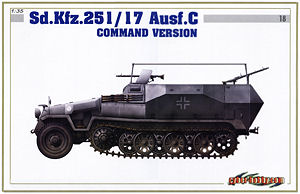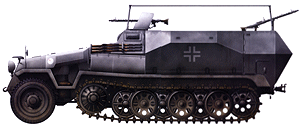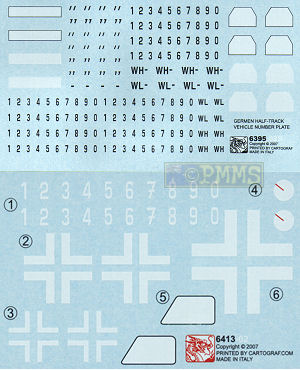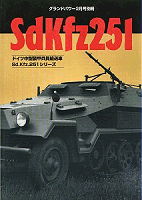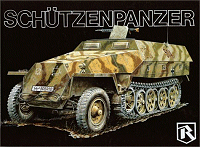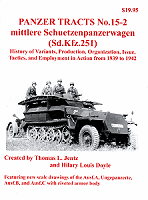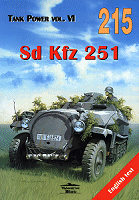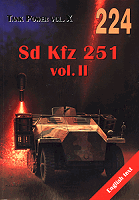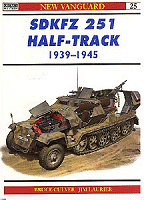The Kit:
The kit as mentioned contains parts from the previous Sd.Kfz.251
Ausf.C kits and included additional sprues for the radios and frame antenna.
Approx. 650 parts in light grey plastic (including individual link track)
- 16 clear plastic parts
- 1 frets of etched parts
- 2 pre-formed brass width indicators
- 5 DS vinyl driver parts
The standard of plastic moulded is again very good with very clean and
crisp mouldings and virtually no pin ejector marks to be seen after the
parts are assembled, but some of the “older” parts have larger
mould seam lines as they are showing their age a little. There are again
many small knockout ‘nodes’ on most of the parts and this does
require a bit more cleanup of the parts and care with the smaller parts
where the nodes are sometimes larger than the part but the end result is
very clean and blemish free parts so the little extra effort is worth it.
Those few pin marks present are quite shallow and easy to remove and as
mentioned are there aren’t many in any case.
The quality of the etched parts is also very good and on a par with contemporary
etched sets with clean etchings and the usual engraved bend lines to help
in the process.
Lower Hull:
This consists of a shallow lower tub with separate axles allowing them
to be positioned any way you like as well on the inside is the front transmission
and final drives, the large fuel tank, battery and rear oil tank. All
of this can’t be seen after you attach the upper hull so it’s
best to just bypass this for quicker assembly as it has no bearing on
the rest of the kit.
The front axle is in two parts with separate stabilizer arms and with
the two part steering arm now included with the front wheels able to
be assembled so they are steerable and the leaf springs articulate, the
detail on these parts is good but the main axle and springs are slightly
undersized. Also included is a separate lower suspension armour panel
sometimes fitted and this simply fits over the existing hull detail.
Running Gear:
This kit again has the revised drive sprockets from kit #6395 with the drive “teeth” in the form of
small rollers that intermesh with the track links, the drive sprockets
themselves also have flat facet sections around the sprocket that the track
links “sit” flush on as the pass around the sprocket, this
is a design feature of all production Halftracks from Kettenkraftrads
to FAMOs as far as my references tell me and not due to wear.
The new sprockets have separate rubber sections, one set perfectly
round and the other with the flat facet sections and you should use
the faceted parts unless building a prototype or early Ausf.A and are
not applicable to this kit.
Detail on the sprockets is quite nice and the large pin mark
in the middle of the hub from the previous kit has been rectified leaving just the smallest of outline which is very easy to smooth over and as mentioned previously there is different designs for the hub, with this kit featuring
one and the AFV Club another so they are both correct with the hub
detail.
You have to be very careful when fitting the rubber section to get
the offset of the faceted section with the drive tooth which is different
each side and the instructions give a diagram to help get this right.
One point is the rubber section extends out past the hub rim where
most photos show this narrower than the rim and thinning the rubber
section will give this effect.
The assembled sprockets look good but we still have the issue where the drive teeth are slightly wider than
the old sprockets and the track provided in the kit is a very tight
fit around the sprocket requiring a bit of pressure to ‘squeeze’ them
onto place and they tended to ‘pop’ off easily.
If you were to cut the sprocket notches from the inner sprocket half
(parts E3) the track will then fit around the sprockets much easier
and you could just trim the notches from the section of the sprocket
the track covers and leave them on the exposed teeth for a better appearance
and keep some of the new details.
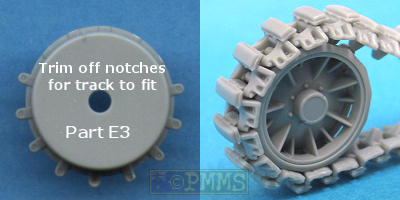
Also included are new outer road wheels that include better detail
on the holes and fine embossing on the rubber section and these are
an improvement over the previous wheels and are now on a par with the
AFV Club wheels that were included in their 251 kits from day one.
Tracks:
These are the same individual links with separate track pads as with
previous kits and when assembled are fully workable. The details on the
links is excellent with assembly being straightforward with the now standard
method for this type track of each link fitting onto the next and held
in place by the track pad stuck on top, but watch the orientation of the
three pins on the back of the pad as they only fit one way around.

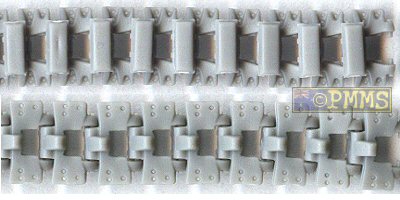
Hull interior:
The main floor section has nice tread plate pattern included with the
two crew seats have spring details on the back with optional etched springs
if you wish and the floor is glued to the lower hull tub but the rest
of the interior is still sadly lacking in detail.
The driver’s steering wheel is undersized; the gear levers are
very basic with the hand brake in particular just being a stick and lacking
any detail with the driver's foot pedals being just plain plastic squares
glued to the firewall again lacking any detail.
The central transmission hump is also way undersized and should be larger
in width and length and this is due to the position of the engine bulkhead
which is 9mm too far back leaving no room for the correct sized hump.
Some modellers have reported problems fitting a drive figure to the
Dragon 251 Ausf.C kits and this is the reason as there is no room for
the driver’s legs with the firewall being so far out of position.
You get in this kit the original DS vinyl driver figure to use as required
taking the above comments into account.
On the bulkhead the left side offset is simulated only and is not actually
offset as it should be and while the raised instruments have nice detail
the position of the steering wheel attachment is too low lacking the
distinctive indent under the wheel quadrant.
At the back the large door hinges are moulded in one piece each but
are also way undersized and look rather flimsy when compared to photographs
of the real things and there are two new crew seats at the back of the
compartment for the gun crew from the standard /17 which are finely moulded.
The raised floor section for the 20mm gun mounting is still included which
includes nice tread plate pattern but is about 9mm shorter than the same
panel in the AFV Club kit and as I don’t have specific info on
this I can’t say which is correct. But the AFV
Club floor does
cover the full width of the fold down side openings which does sound
logical while the Dragon panel only covers about three quarters of the
opening leaving little room for the gun crew to stand on while servicing
the gun?
There is also the raised gun platform on four legs and this is moulded
as one piece for easy assembly as there isn’t any while the AFV
Club platform has the four legs separate for a bit more assembly and
as mentioned the 20mm FlaK38 gun is not included in the kit as it was dispensed with in the Command Version.
Upper hull exterior:
The two lower side panels are separate parts with the cut-outs for the
rear gun section included and these simply glue in place between the
inner floor and lower hull tub with a separate rear hull section added
but the plastic is very thick and this is apparent with the cut-out sections.
There is still an issue with the hull width which has been increased
by 1mm from that of the previous 251 Ausf.C kits but is still 1mm too
narrow when compared to the latest plans in the Panzer
Tracts 251 books
#15-2 and #15-3 as well as to stated hull dimensions.
The increased upper hull width does allow for the top overhang as it
should be on the Ausf.C but you have to wonder if you are going to alter
the hull width at all why not go the whole hog and increase it by the
full 2mm which was the discrepancy on the previous kits?
The answer is quite simple because the lower hull panels have not been
altered (other than the drop side cut-outs) meaning they are still too
narrow and if the top hull was increased by the full 2mm the overhang
would have been more like a veranda?
The upper superstructure is in two sections meaning of course you don’t
have to cut them apart as with the AFV Club kit with the forward section
including the engine compartment with separate engine bay doors and also
separate visors on the upper section with these having three part inner
brackets for nice detail.
On the top is the original roof panel with the curved bullet splash guard which is correct for this version.
This panel includes the inside head padding detail missing from the straight panel in the /17 kit.
The engine compartment side armoured intake covers are separate parts
as is the front hull panel and the side fenders are full length single
pieces with separate small storage boxes, front exhaust and nicely moulded
pioneer tools but most will replace the tool clips with etched items.
The hull drop sides can be positioned raised or lowered but are not
movable with the hinge linkages able to be fixed as extended or folded
depending on your choice of position?
One issue is the length of the drop sides (and hull cut-out) on the
Dragon kit is 3mm longer than on the AFV
Club kit and as the two sets
of 251/17 plans I have contradict each other on this it’s difficult
to determine which is correct? But using the trusty Mk.1 eyeball with
available photos of the vehicle the Dragon kit does appear to have the
better contours of the drop sides while they appear less so for the AFV
Club kit.
The short rear hull section fits in place with separate flanges for
the ends of the hull cut-outs but remember to trap the rear doors between
the upper and lower rear hull sections as you fit these.
Other parts for the hull include the front headlights with black out
covers, Notek light the width indicators from pre-formed brass and the
side aerial mount as well as new finely moulded rifle racks for the hull
sides as these were relocated from inside the vehicle on the 251/17 and
added to the rear doors are racks for two jerry cans.
Two nicely detailed MG34s are provided to be fitted front and rear and most photos of the Command Version show these guns fitted.
Also included is the large frame antenna and the four support legs which match photos well but you should note that these support legs on all German vehicles with the large frame antennas are made of wood and left unpainted, so watch this when painting for authenticity.
Radios:
The main addition for the Command Version is the additional radio sets included and the kit offers a choice of radio rack arrangements mounted either beside the driver or in the back right corner of the hull compartment. As no photos of the vehicle interior exist in the public domain that I am aware of it can't be said if these arrangements are correct or not so we must take them on face value but the locations do seem logical.
Detail on the radio set faces is very well defined and you get in the kit the Fu7 transmitter and Ukw.E.d1 receiver used for communications with Luftwaffe units and the Fu5 transmitter and U.kw.E.e receiver for ground vehicle communications.
The radios have separate multi-part mounting brackets and the assembled units looks good for plastic parts but the inevitable etched sets will no doubt have etched frames for a finer appearance, but as mentioned the racks are well done for plastic items.
Also included is the battery pack with finely moulded frame rack that fits under the right side of the upper hull panel and adding wiring to the radio and battery racks would finish off the assemblies nicely.


